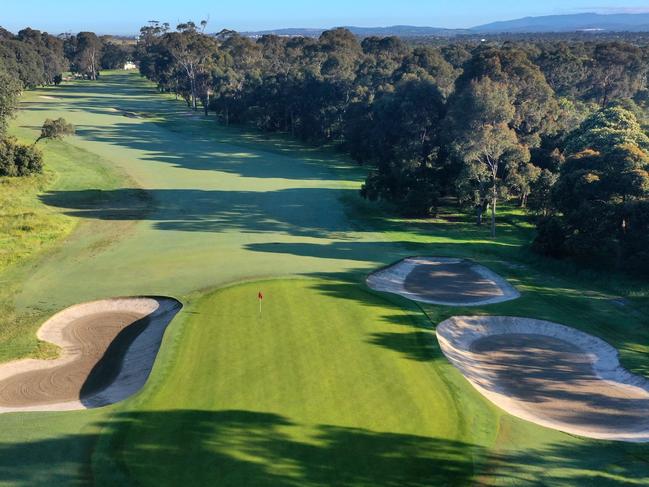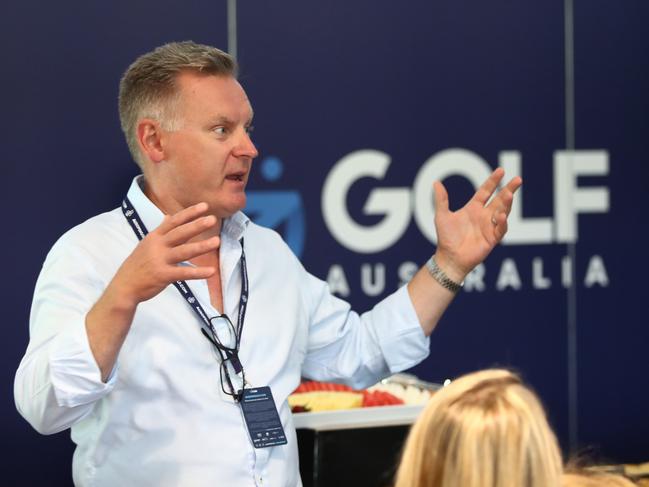Golfers tee off over courses for housing estates suggestion
Australia’s top golf body has slammed a plan to turn courses in Melbourne’s southeast into residential estates, amid Victoria’s housing crisis. Here’s what it had to say about why greens matter.
Victoria
Don't miss out on the headlines from Victoria. Followed categories will be added to My News.
Australia’s peak golfing body has come out swinging over a suggestion Melbourne courses are ripe for redevelopment as residential estates, amid Victoria’s housing crisis.
Golf Australia’s Damien de Bohun said developers and the Allan government should keep their hands off Victorian courses and look elsewhere for land.
The Victorian government has committed to building 800,000 new homes over the next decade and property developers believe golf courses in Melbourne’s southeast — in prime locations with infrastructure and amenities — could be ideal spots to build new estates.
But scores of Victorians have teed off furiously at the suggestion, saying they love the golf courses in their suburbs and towns, and don’t want to see them sold-off and developed.
As of 2.30pm Thursday, a whopping 78 per cent of Herald Sun readers who responded to an online poll did not want to see golf courses become housing estates.
“We actually need more golf courses, not less … golf is absolutely booming at the moment,” Mr de Bohun, who is general manager of Golf Australia’s Places to Play, said on Thursday.

More Victorians were golfing than ever — with its well documented physical fitness, mental health and social benefits — and people travelled from overseas just to play on Melbourne’s famous sandbelt courses, contributing vital tourism dollars to the state, he said.
Research showed on-course golfers were 7.1 per cent happier than non-golfers while a recent national report revealed the sport drove more than $10bn in economic expenditure, $3.3bn worth of community benefits and $1bn of social benefits a year, Mr de Bohun said.
In Victoria alone, golf generated $844m in total benefits a year, $349m in economic benefits, $256m in social benefits and $239m in environmental benefits, a Golf Australia report shows.
“More than 3.5 million people played golf last year and we had a 15.9 per cent increase in golf participation in competition rounds last year overall — probably more importantly, we saw a 39 per cent increase in golfers under the age of 18,” Mr de Bohun said.
“We are acutely aware that there’s a housing crisis but golf courses are not the solution to that because we need to find a much smarter way to shared access around green spaces.
“It’s one thing to build homes but it’s another thing to take away people’s way of undertaking their recreation to do that.”
Even those who did not play golf derived benefits from looking at the sweeping green spaces, trees and wildlife on courses in their communities, Mr de Bohun said.
Past president of the Urban Development Institute of Australia (UDIA) and CEO of major property development group Intrapac, Max Shifman, said on Wednesday golf courses were ripe for development and could be unlocked very quickly, which was what was needed in a housing crisis.
“Golf courses represent an incredible opportunity in the midst of a housing crisis to develop affordable housing in typically quite established parts of Melbourne, where you’ve got infrastructure and amenities,” Mr Shifman said.
“In all honesty, the golf courses are one of the biggest opportunities we have, if government was actually willing to make some brave decisions.”


Master Builders Victoria chief Michaela Lihou said partial redevelopment of golf courses for housing needed to be explored, alongside “a greater discussion around planning”.
“The repurposing of golf courses for housing developments presents an opportunity to design buildings that maximise liveability and sustainability through passive design,” she said.
“While this is not the sole solution to our state’s housing needs, it is one option that should be considered to assist in addressing the housing shortage while considering existing planning overlays and environmental factors.”
A Victorian government spokesperson said everything possible was being done to deliver the 800,000 promised new homes.
Government planning guidelines for the conversion of golf course land to other purposes had been released in June 2020, “to provide guidance on preparing a proposal to redevelop a golf course to ensure a net community benefit and a quality outcome”, she said.
A Golf Course Redevelopment Standing Advisory Committee had also been established to consider proposals and public submissions for golf course redevelopments.
“Last year we introduced nation-leading housing reforms and we’ll continue to pull every lever we can to help industry build 800,000 homes over the next decade,” the government spokesperson said.



